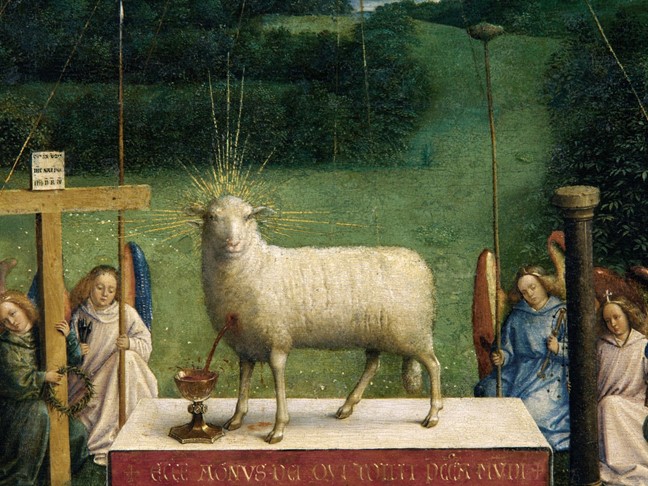Major Discovery in van Eyck's Ghent Altarpiece, Adoration of the Mystic Lamb

The Ghent Altarpiece, Adoration of the Mystic Lamb is a large and complex 15th-century polyptych from St. Bavo's Cathedral in Ghent, Belgium. The work is attributed to Early Flemish painters, brothers Hubert and Jan van Eyck.
The Ghent Altarpiece, Adoration of the Mystic Lamb is a large and complex 15th-century polyptych from St. Bavo's Cathedral in Ghent, Belgium. The work is attributed to Early Flemish painters, brothers Hubert and Jan van Eyck. This masterpiece of European art is considered to be one of the world's treasures.
The panels are organized as two vertical sections with double sets of foldable wings and interior and exterior panel paintings. The upper inner panels form the central Deësis of Christ the King, Virgin Mary and John the Baptist. The adjacent panels show angels playing music and on the far outermost panels are the naked figures of Adam and Eve. The four lower panels are divided into two pairs: sculptural paintings of St. John the Baptist and St. John the Evangelist and donor portraits of Joost Vijdt and his wife Lysbette Borluut. The central panel of the lower register depicts a gathering of saints, sinners, clergy and soldiers attending an adoration of the Lamb of God, among several groupings of figures, overseen by the dove of the Holy Spirit. This altarpiece is one of the most renowned and important artworks in European history.

Jan van Eyck, The Ghent Altarpiece Open. Dutch: Het Lam Gods (open).

Jan van Eyck, The Ghent Altarpiece Open. Dutch: Het Lam Gods (open), detail.

Detailhead ofthe Lamb before treatment. Sint-Baafskathedraal Gent © Lukasweb.be-Art in Flanders vzw, foto KIK-IRPA

Detail head of the Lamb after overpaint removal. Sint-Baafskathedraal Gent © Lukasweb.be-Art in Flanders vzw, foto KIK-IRPA
The Royal Institute for Cultural Heritage (KIK-IRPA) began a full-scale conservation treatment of the painting in 2012. Hélène Dubois, project leader of the treatment for KIK-IRPA and a researcher at the University of Ghent, explained that in a 16th century text, the painting was described as, "a painting with beautiful flowers in a wide landscape, strong faces of the characters looking at the altarpiece painted behind a fountain.” Research revealed that in the 16th century, the painting was 45% overpainted. Upon restoration, the clothes and houses appeared changed, as well as the horizon and the lamb. After the current conservation treatment of the painting, researchers discovered that the original lamb painted by van Eyck looked wholly different. The face of the lamb now appears to be anthropomorphic, part animal and part human. The lamb displays an intense expression with soulful, almost human eyes aimed at the audience, focused on the faithful in that time and perhaps in the present day as well.
Royal Institute for Cultural Heritage (KIK-IRPA): http://www.kikirpa.be/EN/
